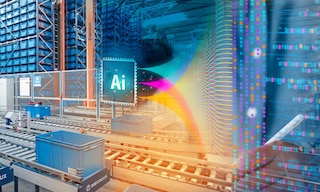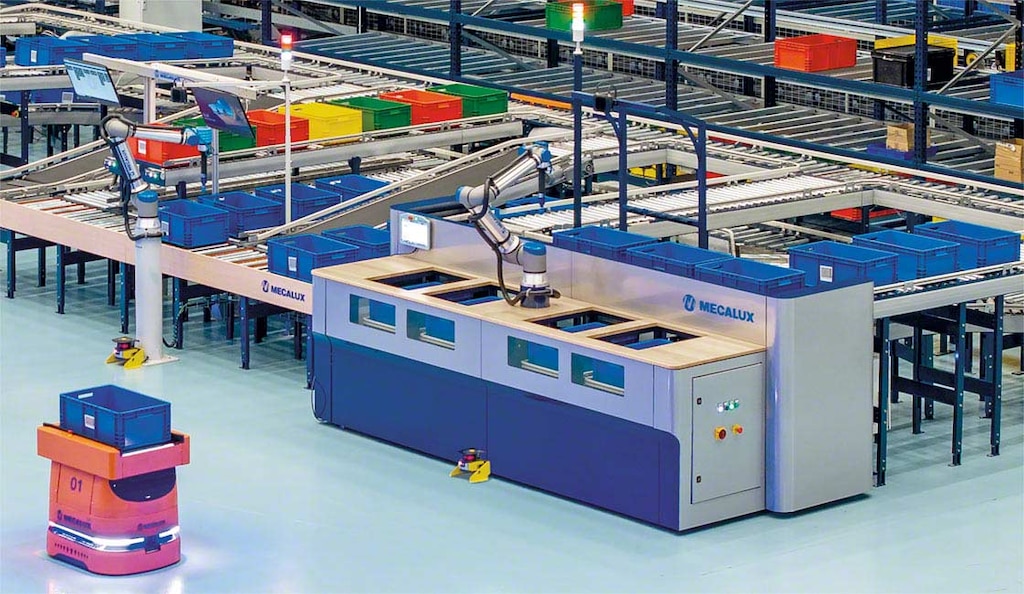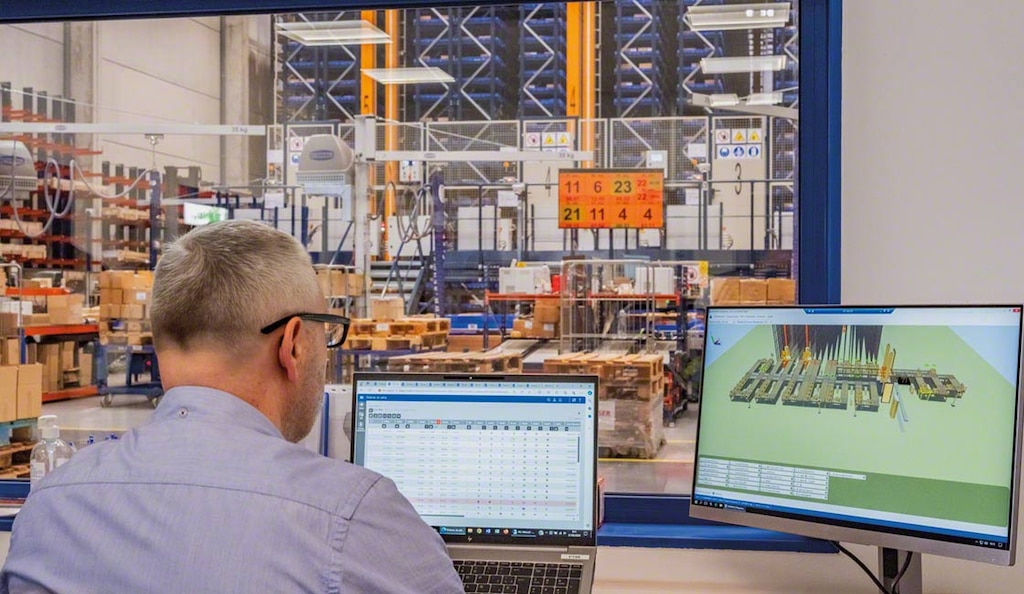
How to use artificial intelligence: Business applications and examples
Artificial intelligence (AI) has become an integral part of modern business. Understanding how to use AI gives companies powerful tools to solve everyday challenges and streamline operations. This technology delivers real value, especially in industries where efficiency is a competitive advantage.
In logistics, for example, AI plays a vital role in predicting consumer trends, preventing stockouts, and optimizing the movements of warehouse associates and autonomous mobile robots (AMRs), improving operational efficiency.
How to use artificial intelligence
AI relies on large volumes of data to identify patterns, make probabilistic predictions, and operate autonomously in certain scenarios. One of its core goals is to replicate human abilities — such as reasoning and learning — while processing visual, auditory, or tactile information through advanced algorithms and sensors.
Artificial intelligence can be used in several ways:
- Natural language processing (NLP). This technology enables computer systems to understand, interpret, and communicate in human language. It is critical for automatically sorting emails (e.g., separating spam from important messages), translating text in real time, analyzing sentiment on social media, and detecting fraud in legal documents.
- Computer vision. AI can extract insights from images, videos, and other visual inputs. Computer vision is employed in facial recognition systems for security and identification, smart traffic cameras, and autonomous mobile robots (AMRs), among other applications.
- Machine learning. IT systems become more reliable over time by analyzing large datasets and adjusting outputs based on detected patterns. Machine learning is commonly found in smartphone voice recognition and personalized product recommendations during online checkout.
- Generative AI (GenAI). This form of AI autonomously creates new content (e.g., images, text, audio, or videos) drawing on patterns learned from existing data. One of the most well-known GenAI applications is ChatGPT, a large language model (LLM) that has helped bring this technology into mainstream use. GenAI can be used to write product descriptions for online stores, generate personalized chatbot replies, produce content for ad campaigns, and even draft contracts based on specific requirements.
To perform these functions, AI leverages several tools, including:
- Data collection. Processing structured data (such as databases) and unstructured data (text, images, and videos).
- Data analysis. Identifying patterns, trends, and relationships within large volumes of information.
- Data visualization. Creating graphical representations that make results easier to understand.
- Decision-making. Generating recommendations based on statistical models and machine learning algorithms.
Artificial intelligence is transforming industries across the board, and its impact will only continue to grow as new technologies emerge. Implementing AI can improve productivity, safety, and quality of life in countless fields.

What do I need to use artificial intelligence?
To implement AI, two key components are essential: data and algorithms. Data are the foundation. They feed the system and enable AI to learn patterns by processing and analyzing large volumes of information. Algorithms, meanwhile, provide the instructions the artificial intelligence follows to process that data and improve its performance over time. Together, they make it possible for AI to perform specific tasks autonomously and efficiently.
To integrate artificial intelligence into daily operations, companies can follow these practical steps:
- Identify areas for improvement: Look for repetitive processes where AI could add value.
- Standardize data: Organized, accessible, and reliable inputs are critical for training AI models successfully.
- Select the right tools and technologies: There are many solutions on the market — such as virtual assistants or cloud-based AI platforms — tailored to different business needs.
- Train your team: Bring in or upskill talent in areas like data science, business analysis, or data engineering.
- Implement in phases: Start with pilot projects to measure the impact and make adjustments before scaling up.
What are the 3 types of artificial intelligence?
AI aims to mimic functions traditionally associated with human intelligence. Today, certain AI systems can perform specific tasks with high precision (narrow AI). Other types — namely general AI and super AI — are still largely conceptual and represent the future of the technology. Let’s explore these three categories and how they’re evolving.
- Narrow AI. This refers to systems designed to carry out specific tasks within a particular domain, such as medical diagnosis, chatbots, and predictive maintenance. While these AI systems can’t adapt like humans, they help improve operational efficiency, handle repetitive work, and enhance decision-making in industries like manufacturing, healthcare, and marketing.
- General AI. This looks to create AI systems that replicate human intelligence, with the ability to learn autonomously and adapt to new tasks without requiring specialized training. Unlike current systems, which are limited to predefined functions, General AI would be capable of solving complex problems across a wide range of contexts.
- Super AI. This concept borders on science fiction. In this scenario, AI systems would surpass human cognitive abilities, operating with complete autonomy. Super AI could make complex decisions independently in multiple fields, learn continuously without human input, and perform tasks far faster and more accurately than humans. Although still theoretical, the idea of Super AI raises both exciting possibilities and serious ethical challenges. Its potential to transform industries like medicine, transportation, and scientific research is immense — but so are the questions around control and responsible use.
How can AI be used in logistics?
The use of AI in logistics is evolving rapidly and is expected to reach its full potential in the coming years. Several practices are already gaining ground in the industry:
- Demand forecasting. Machine learning algorithms can predict future demand by analyzing sales data, purchasing patterns, and external factors such as market trends, seasonality, and shifts in consumer behavior. This helps businesses optimize their inventories, cut costs, and improve production and distribution planning.
- Data processing and utilization. In logistics, AI facilitates data management and quick access to relevant information. For example, Interlake Mecalux’s Easy WMS warehouse management system incorporates a GenAI-powered chat that allows users to query data on their facilities and generate custom dashboards through natural language conversations. These capabilities streamline decision-making and operational efficiency.
- Warehouse automation. Integrating advanced robotics and WMS software speeds up storage and order fulfillment tasks. AI improves these operations with algorithms that optimize inventory distribution, forecast demand, and coordinate robots in real time.
- Order processing. AI is reshaping picking operations through systems that combine computer vision and machine learning. These technologies enable robots to recognize and handle products of different shapes and sizes with speed and precision, reducing errors and increasing fulfillment throughput. A prime example is Interlake Mecalux’s picking robot, which automates item retrieval in warehouses using intelligent AI-driven technology.
- Transportation and routing. AI leverages machine learning algorithms and predictive analytics to process real-time information (traffic, weather, vehicle availability) and plan more efficient delivery routes. These algorithms can automatically adjust itineraries to shorten lead times and cut operating costs.
- Smart packaging and sorting. Integrating AI into a WMS makes it possible to analyze the weights and dimensions of goods to arrange them optimally within a package. This maximizes space usage while minimizing packaging material.
- Customer service. AI chatbots and virtual agents can respond to common inquiries, such as order status or product availability, quickly and accurately. By analyzing past interactions, AI also tailors responses and enhances the user experience, reducing wait times for issue resolution.
AI in warehouse management improves delivery date accuracy, inventory management, and processes like order fulfillment. Through AI-powered data analysis, businesses can better adapt to market changes and increase efficiency across their supply chains.

AI is transforming business
Artificial intelligence is reshaping how companies operate and revolutionizing industries like logistics. With its ability to process vast amounts of data, AI supports decision-making and optimizes tasks — boosting both efficiency and competitiveness. Is your business looking for software that enhances decision-making through AI? Interlake Mecalux’s Easy WMS simplifies internal processes, makes the most of available resources, and responds swiftly to market demands. Want to learn more about how AI can help your business evolve? Get in touch with us and discover how our solutions can take your operations to the next level.
